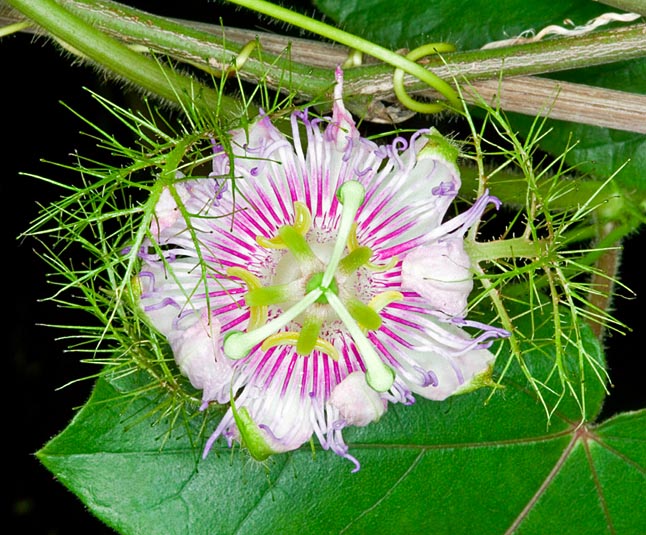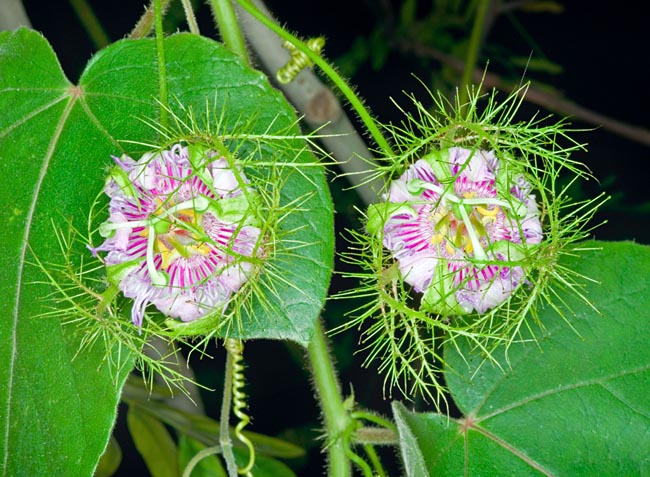Family : Passifloraceae

Text © Pietro Puccio

English translation by Mario Beltramini

Passiflora foetida is a tropical climber with 2-5 cm flowers and edible fruits © Giuseppe Mazza
The name of the genus is the combination of the Latin terms “passio, -onis” = passion and “flos, -oris” = flower with reference to the structure of the flower where the first Spanish missionaries did see the instruments of the Passion of Christ; the name of the species is the Latin adjective “foetidus, a, um” = fetid, stinking, with reference to leaves’ smell.
Common names: fit weed, love-in-a-mist, love-in-a-mist passionflower, mossy passionflower, running pop, stinking granadilla, stinking passionflower, stinking passionfruit, wild passionfruit, wild water-melon (English); Marie-goujat (French); maracujà da pedra, maracujà de cobra, maracujà de lagartinho, maracujà de cheiro (Portuguese-Brazil); bombillo, clavellín blanco, injito colorado, granadilla de culebra, granadilla silvestre, parchita de culebra, pasiflora hedionda, tagua-tagua (Spanish); Stinkende Grenadille (German).
The Passiflora foetida L. (1753) is a perennial climbing species which anchors on the supports by means of tendrils produced at the axil of the leaves; it presents thin cylindrical stems, 2-5 m long, covered by thin yellowish sticky glandular hairs. The leaves, on an up 6 cm long petiole without glands, are alternate, hairy, 5-9 cm long and 3-8 cm broad, with 3-5 lobes quite variable as shape, with central lobe slightly longer than the lateral ones and entire or slightly toothed margins. The stipules (appendages at the base of the petiole having the task to protect the leaf during the first stages of development) are often deeply subdivided into filiform segments provided with apical glands; the leaves, when wrinkled, emit a pungent odour, considered by many unpleasant.
Hermaphrodite flowers, axillar, solitary, of 2-5 cm of diameter, of white, pink or purple colour, on a 3-6 cm long peduncle, subtended by three prominent bracts of pale green colour, 1-3-pinnate with filiform segments provided with apical glands, corolla with 5 ovate-oblong sepals and 5 oblong or oblong-lanceolate petals slightly shorter than the sepals, crown with two series of purple filaments with white extremity, about 1 cm long.

The wrinkled leaves have pungent odour. They are poisonous but with medicinal virtues © Giuseppe Mazza
Following varieties are recognized: Passiflora foetida var. gossypiifolia (Desv. ex Ham.) Mast. (1871); Passiflora foetida var. hispida (DC. ex Triana & Planch.) Killip (1931); Passiflora foetida var. fluminensis (M. Roem.) Killip (1938); Passiflora foetida var. polyadenia (Griseb.) Killip (1938); Passiflora foetida var. quinqueloba (Griseb.) Killip (1938); Passiflora foetida var. riparia (C. Wright ex Griseb.) Killip (1938); Passiflora foetida var. orinocensis (Killip) Feuillet (2007).
Fast-growing species, it prefers the tropical and humid subtropical climates and an exposition in full sun or slightly shaded, its cultivation may be tried also in the warm temperate ones where temperatures of some degrees under the 0 °C are short-lasting exceptions. Utilizable as climber or as soil cover on various types of soil, even rocky and stony; it well adapts to the cultivation in pot in very luminous position, with winter lowest temperatures preferably not under the 14 °C, the waterings must be regular and abundant in summer, in winter the substratum is to be kept slightly humid. The pulp surrounding the seeds, wich its sweet, slightly acidulous taste and excellent aroma, is consumed raw or used for aromatizing beverages.
All parts of the plant contain toxic substances, in particular cyanogenetic glucosides, excepting the ripe fruits, in concentrations sufficiently high to cause in some instances the death of goats and other animals; the leaves are utilized in the traditional medicine for various pathologies.
Synonyms: Passiflora vesicaria L. (1760); Passiflora variegata Mill. (1768); Granadilla foetida (L.) Gaertn. (1788); Passiflora hirsuta Lodd. (1818); Passiflora polyadena Vell. (1827); Passiflora nigelliflora Hook. (1838); Tripsilina foetida (L.) Raf. (1838); Passiflora hastata Bertol. (1840); Decaloba obscura (Lindl.) M.Roem. (1846); Dysosmia ciliata M.Roem. (1846); Dysosmia foetida (L.) M.Roem. (1846); Dysosmia gossypiifolia M.Roem. (1846); Dysosmia hastata M.Roem. (1846); Dysosmia hibiscifolia M.Roem. (1846); Dysosmia hircina Sweet ex M. Roem. (1846); Dysosmia nigelliflora M.Roem. (1846); Dysosmia nigelliflora M.Roem. (1846); Dysosmia polyadena M.Roem. (1846); Passiflora baraquiniana Lem. (1861); Passiflora liebmannii Mast. (1872); Passiflora marigouja Perr. ex Triana & Planch. (1873); Passiflora muralis Barb. Rodr. (1891); Passiflora balansae Chodat (1902); Passiflora pseudociliata Britto (1917).
→ To appreciate the biodiversity within PASSIFLORACEAE family please click here.
